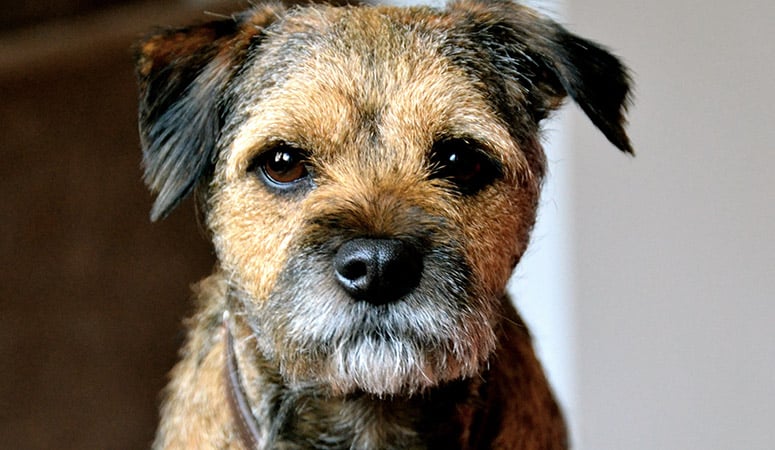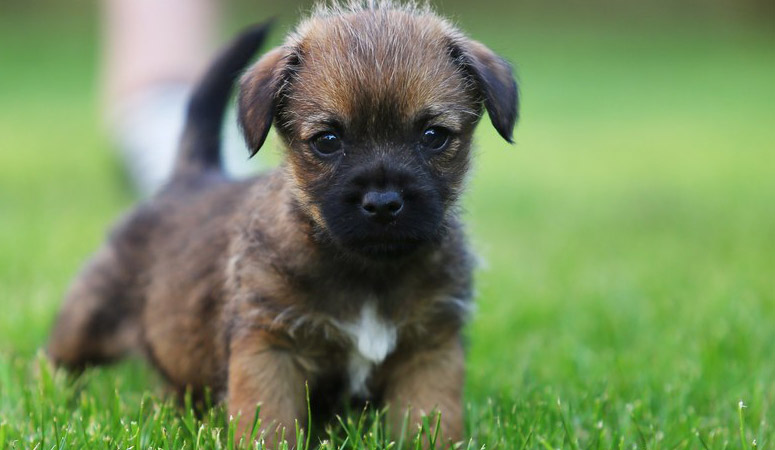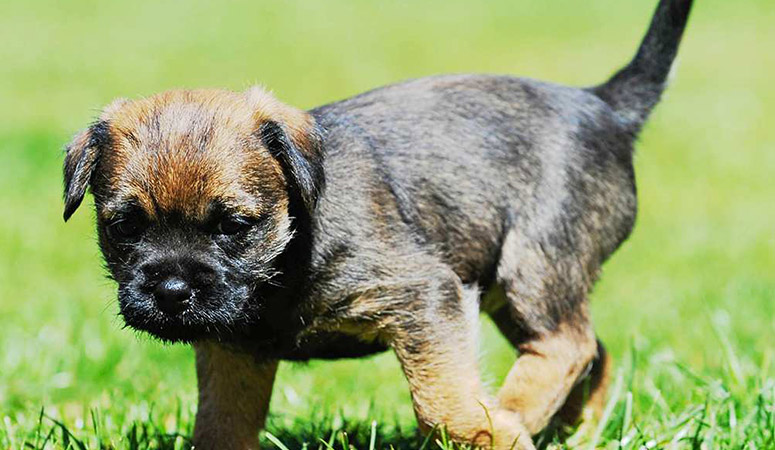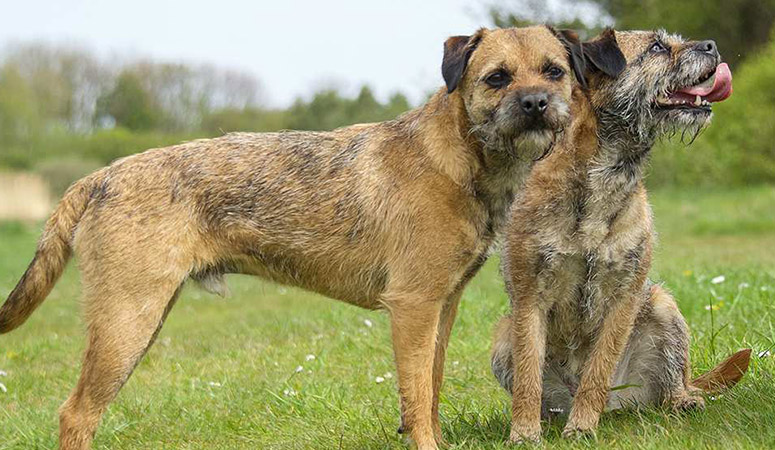Border Terrier
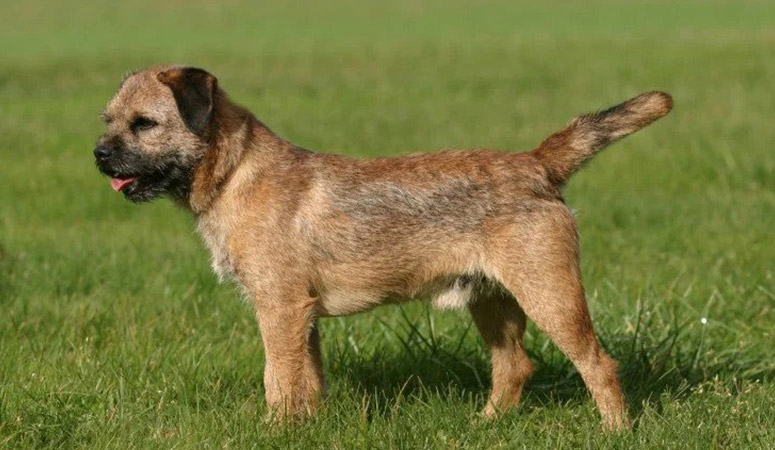
With “otter head” and longer legs than other small terriers, the Border Terrier are known as tough, no-frills working terriers with the temperament of affectionate and trainable. The breed enjoys exploring outdoors, which makes them good childhood playmates. Bred to be country dogs, Borders adapt well to city life as popular pets if they get plenty of exercise.
| Other Names | ReedWater Terrier, Coquetdale Terrier |
| Color | Red, Wheaten, Blue & Tan, Grizzle & Tan, |
| Height | Males: 11-16 inches. Females: 11-16 inches. |
| Weight | Males: 13-16 pounds. Females: 11-14 pounds. |
| Life Span | 12-15 years |
| Personality | Affectionate, Happy, Plucky |
| Exercise | Regular Exercise |
| Origin |
| Popularity | #84 |
| Groom Needs | Weekly Brushing |
| Kids Friendly | Yes |
| Dog Friendly | Yes with supervision |
| Watch Dog | |
| Family Dog | Yes |
| Litter Size | 2 to 8 puppies |
Border Terrier Pictures
Border Terrier Video
Introduction
Fancied a true working Terrier, the Border Terrier is a hardy dog breed which presents longer legs than the usual terriers. Their harsh and wiry coat has a close undercoat. Border Terriers come in a finite array of colors, including grizzle and tan, blue and tan, wheaten, or red. Borders are a breed that fancies the outdoor play and the good old fashioned gamboling. They do well if they exercise regularly.
A standard male of this breed stands at a shoulder height of 13-16 inches, quite larger than a similar female, which measures around 11-14 inches. The normal weight of Borders ranges between 12 and 16. They have an average lifespan of 11-15 years. Borders have adapted to the American terrain better than most terriers, yet they aren’t a very popular dog breed.
Living with Border Terrier
With a double coat—a hard, wiry outer coat over a soft, fluffy undercoat. Just like most double-coated breeds, the Border needs seasonal shedding, and the grooming kit should include a fine comb, a natural bristle brush, and a stripping knife.
Weekly brushing and occasional hand stripping are required to keep its wiry coat in a natural state. It’s the kind of thing you can do while you and your Border are watching a 30-minute television show. If you don’t know how to deal with the work, ask a professional groomer for help.
Baths with shampoo made for the rough terrier coat are necessary only as needed to remove dirt and debris, but they do not need to be bathed often unless it’s really necessary.
Trimming nails once or twice a month will help prevent painful splitting, cracking, or a broken nail. Terriers are sensitive about touching their paws, so get your Border Terrier used to it at his early age.
Brush your Border Terrier’s teeth at least two or three times a week to remove tartar buildup and the accompanying bacteria.
Borders need plenty of exercise every day to keep active. A ball or flying disc or a brisk half-hour walk or play session with his owner is sufficient to keep a Border healthy and happy.
Border Terriers are prone to weight gain and boredom without enough exercise, which can easily lead to destructive behavior and lots of barking.
The Borders enjoy taking part in tracking, lure coursing, agility, as well as canine sports such as flyball.
With instinct to chase small animals, they should be on a leash while walking outside. Besides, play sessions should take place in a fenced yard or other secure areas.
Some Borders don’t like hot weather, so outdoor exercise should be kept to a minimum when the temperature gets above 85 degrees F.
Border Terriers are wonderful dogs who play hard and love harder for right people, whose family can give the dog plenty of exercise and prevent them from practicing their escape-artist skills.
They’ll escape through holes in fences, through open gates and doors, or by any other means they can find if you leave them alone or lack of supervision for too long.
Border Terriers need high-quality dog food or homemade diet, such as meat, rice and vegetables, as well as vitamin and mineral supplements, to meet their nutrition needs. The better the dog food, the further it will go toward nourishing your dog. The amount of dog food depends on its size, age, activity level and metabolism.
You should watch out the dog’s calories consumption and weight to prevent him from obesity and to keep them in good shape by measuring his food and feeding him twice a day, instead of leaving food out all the time.
Clean, fresh water should be available at all times.
Children should never be allowed to touch or remove food while any dog is eating, while food guarding behaviors are not more prominent in the Border Terrier than in other breeds.
A responsible breeder should learn about which human foods are safe for dogs, and which are not. Check with your vet if you have any problems or doubts about your dog’s weight or diet.
Generally, the Border Terrier is healthy, and a responsible owner will screen breeding stock for health conditions such as hip dysplasia, legg-calvé-perthes syndrome, progressive retinal atrophy, canine epileptoid cramping syndrome (CECS), juvenile cataracts, seizures, heart problems, eye concerns and allergies, etc.
His ears should be checked weekly for redness or a bad odor, which can indicate an infection. Brushing teeth with toothpastes designed for the breed is necessary.
It’s important to learn about these diseases if you’re considering this breed, while not all Border Terriers will suffer from any or all of these diseases. Some common health tests recommended from the National Breed Club include hip evaluation, patella evaluation, ophthalmologist evaluation and cardiac exam.
Total Annual Cost: $3177.9
Cost is estimated for the first year and may vary depending on many factors, such as dog food, health care, leash, collar, licensing, possible fencing, crates, training and obedience classes, dog-walking, grooming, treats, toys, flea, tick, and heart-worm meds, microchips, etc.
Intelligent and eager-to-please, it’s easy for the Border Terriers to learn basic obedience, but he may not always obey your requests at the beginning. Early socialization and puppy training classes are a must for Border Terriers.
Border Terriers excel at earthdogging, a popular hunting-like exercise.
Crate training helps with housetraining and will keep your Border Terrier from chewing things while you’re away.
Advanced dog sports and tricks training such as agility are perfect matches to keep Border Terriers’ high energy. And high-impact treats can motivate the breed and give it a go. Jumping is one of the Border Terrier’s favorite activities, which can show them the way around the agility course.
Leash training is another must. It’s amazing how quickly a Border Terrier can run off with strong instincts of chasing prey or adventure, which does not fade with age and if anything, it becomes stronger.
Positive reinforcement techniques, such as praise, play, and food rewards, can help you to get what you ask out of the Border Terrier. Confronted, he will act sorry, since he really likes to please. Punish him harshly, and you will break his spirit.
History
Originally called the Reedwater Terrier, Ullswater Terrier, and Coquetdale Terrier, after the names of places where the breed was populous. The breed name, Border Terrier, was chosen for this breed in the mid-1800s to suggest that they originated from the Scotland-England border counties. In the border counties between Scotland and England, in the United Kingdom, there was a prevalent agricultural practice that involved the rearing of sheep. This brought up a number of extra duties for the breeders or farmers. These included the problems of shepherding, guarding, and herding of this livestock. A most notorious predator of the sheep in this hilly region was the hill fox. Hence, farmers saw the need to breed a dog that had sufficiently long legs to catch up with the pace of a hill fox and yet the small size to crawl into the foxholes. The Border Terrier which was later bred met the requirements.
Some believe that the Border Terrier shares a similar ancestry with other terriers of England, especially the Bedlington Terrier and the Dandie Dinmont Terrier. The ancestors of the Border Terrier were used in the border counties to bolt the hill fox to its lair underground. Their reputation as foxhunts was better known in the northernmost county of Northumberland. Here the Border Terrier tagged along with horsemen who pursued a fox when it steals a sheep from the flock.
In 1920, the Kennel Club recognized the Border Terrier, after it was rejected initially for lack of special and distinct attributes from the other terriers. The American Kennel Club recognized this breed in 1930 and the Border Terrier rose slowly to prominence. Today, they are a well-recognized breed in many countries.
Helpful Information
Breed Club: BORDER TERRIER CLUB OF AMERICA, INC.
Breed Club Link: http://www.btcoa.org/
Breed Club Rescue: BTCA Rescue Network groups
Breed Club Rescue Link: http://www.btcoa.org/rescue/rescue.html

